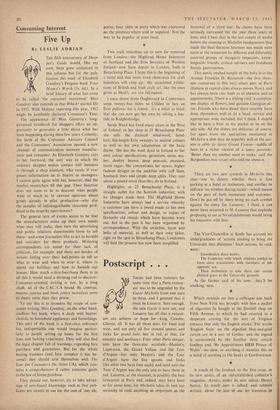Consuming Interest
Five Up
By LESLIE ADRIAN The appearance of Miss Gundrey's long- promised handbook for shoppers offers an op- portunity to generalise a little about what has been happening during these few years. Certainly, the birth of the Consumer Advisory Council and the Consumers' Association opened a new channel of communication between manufac- turer and consumer. As Elizabeth Gundrey says in her foreword, the only way in which the ordinary shopper makes contact with business is through a shop assistant, who rarely if ever passes information on to buyers or managers. I cannot quite agree with her, however, that the market researchers fill this gap. Their function does not seem to be to discover what people want so much as to canvass opinions about goods already in pilot production—why else the samples of indistinguishable chocolate prof- fered in the street by interviewers?
The general turn of events seems to be that the manufacturers make up their own minds what they will make, then turn the advertising and public relations departments loose to sell them—andsome journalists like to act as heralds and outriders for these products. Motoring correspondents are noted for their lack of criticism, for example, and there are hordes of writers falling over their ball-points to tell us what to wear and when to wear it, where to spend our holidays and how to furnish our houses. How much schleichwerhung there is in all this it would need a divining rod to discover. Consumer-oriented writing is not, by a long chalk, all of the CAC/CA brand. By contrast, theatre, cinema' and book critics nowadays seem to damn more than they praise.
To say this is to broaden the scope of con- sumer writing. Miss Gundrey, on the other hand, confines her book, where it deals with buyers' choices, to household appliances and furnishings. This part of the book is a first-class ,reference list, indispensable one would imagine particu- larly to people setting up house for the first time and lacking experience. They will also find the legal chapter full of warnings, regarding hire purchase and guarantees. But for the whole buying business (and how complex it has be- come) they should arm themselves with The Law for Consumers (6s. from CA), which con- tains a comprehensive if rather awesome guide to the law of house purchase.
They should not, however, try to take advan- tage of new-found knowledge such as that pub- licans are unable to sue for the cost of `any ale, porter, beer, cider or perry which was consumed on the premises where sold or supplied.' Not the way to be popular at your local.
Two craft industries up to now far removed from London—the Highland Home Industries of Scotland and the Erin Sweaters of Western Ireland—now have depots in London, both in Beauchamp Place. I hope this is the beginning of a trend and that more town showcases for craft industries will crop up: the occasional exhibi- tions of British and Irish craft art, like the ones given at Heal's, are too infrequent.
I once drove from Oughterard in Connemara some twenty-five miles to Clifden to buy an Erin pullover for a friend: it's a relief to think that she can now get her own by taking a bus- ride to. Knightsbridge.
Sarah Ward has lived many years in the West of Ireland; in her shop at 21 Beauchamp Place she sells the classical oiled-wool, hand- knit, hip-length Erin sweaters in neutral colours as well as her own adaptations of the basic theme. She has the wool dyed in Ireland to her own colour specifications, geranium, stone,,am- ,ber, donkey brown, deep peacock, mustard, burnt sugar. She concentrates her newer. higher fashion designs in the neckline with cuff lines, boatneck lines and simple deep splits. They cost about a pound more than they do in Ireland.
Highlights, at 25 Beauchamp Place, is a straight outlet for the Scottish industries, with no changes made here. The Highland Home Industries haVe always had a service whereby a customer can have a tweed made to her own specifications, colour and design, or copies of favourite old tweeds which have become worn out, but in the past it has been organised by correspondence. With the swatches, loom and bolts of material, as well as their own tailor, right on the spot in Beauchamp ['lace, Londoners will find the process has now been simplified.


































 Previous page
Previous page